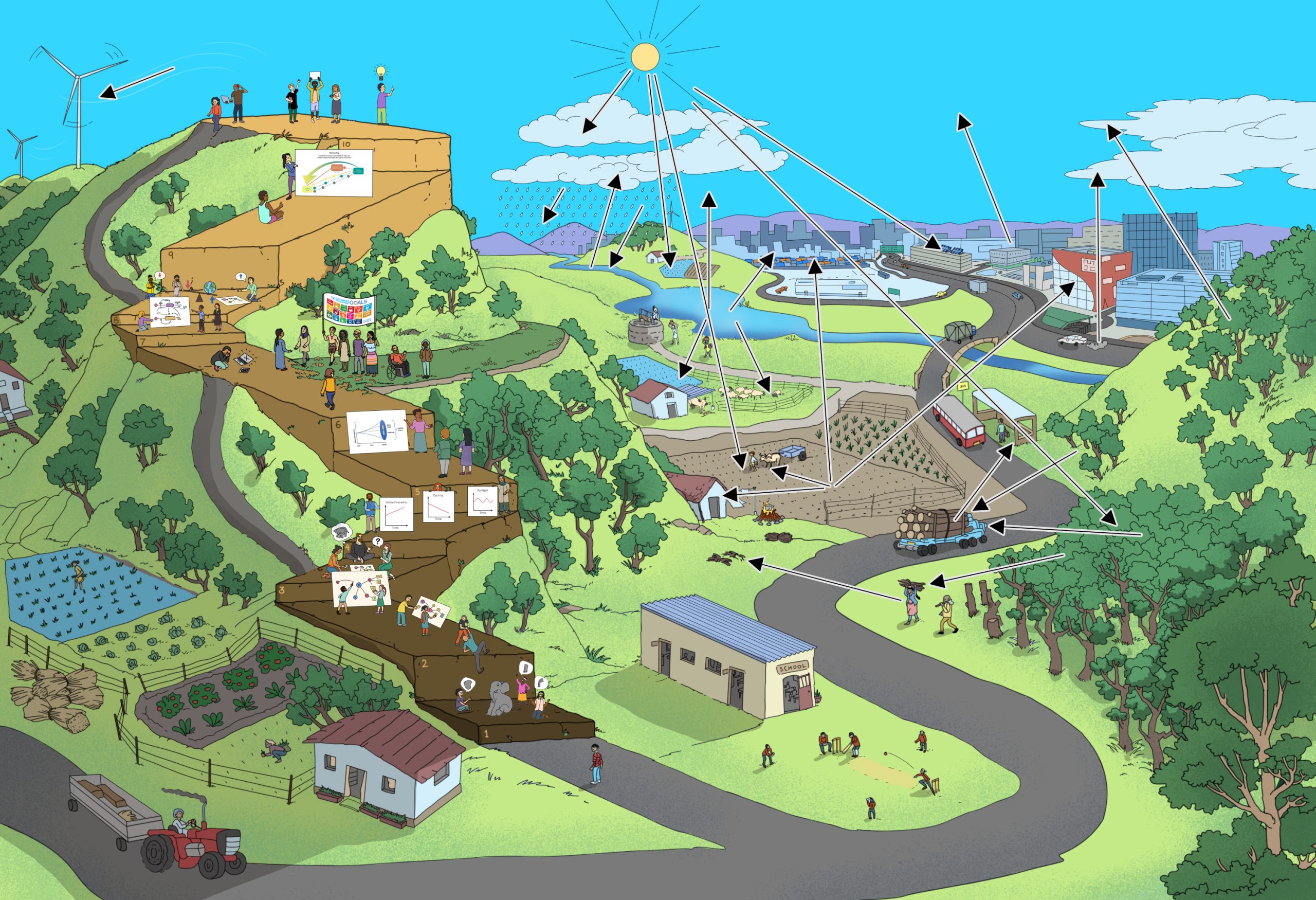Systems thinking is the ability to describe and/ or visualise a part of a complex reality, express that part of reality as a model, understand the model as a system, use the model to explain the behaviour of the system, anticipate the behaviour of the system, and evaluate its impacts on sustainable development, identify potential points of, and types of interventions, generate options to act, assess their impacts in the frame of sustainable development, and decide whether further actions are necessary or not.
1. What does this mean?
In Step 1 the learners created a detailed structured description. In Step 2, they build on the structured description to create a model, by identifying each element of the chosen topic, the connections or interrelationships between the constituent elements, and how they work together. This develops a deeper understanding and opens new perspectives about the topic and its status.
What is a model?
A model is a simplified picture or depiction of a part of reality.
The aim of (scientific) modelling is to clarify and organize one’s own thinking and make it shareable with and communicable to others.
To do this you select and identify relevant components or elements and (inter)linkages of a topic), that express what you perceive about the topic at that moment. You might use different kinds of models to strengthen understanding about the topic. For example:.
- A Globe is a 3D model
A globe is a model of the much more complex world. But the globe depicts the position of the continents and oceans, gives us an idea of topographic relation of mountain ranges, rivers, or states etc. The globe makes the earth more understandable, while in reality, it is a very complex system!
- A diagram of the Water Cycle is a graphical model
The global water cycle is a well-known model. It visualizes the evaporation of water over the oceans and the condensation of water vapour in the form of clouds. These clouds cause precipitation over the oceans and, driven by winds, also over land. Precipitation feeds ground water, as well as surface waters like creeks and rivers, which finally end up in the oceans again, and the cycle starts all over again.
- An equation is a conceptual model
The Pythagoras theorem states that the area of the square whose side is the hypotenuse is equal to the sum of the areas of the squares on the other two sides, is depicted as a2 + b2 = c2
2. What is the aim?
To enable learners to
- enrich the description of reality created in Step 1
- convert the structured description into a model (static model)
- assess the quality of the model
4. Activities, tasks and suggested learning methods
In order to achieve the aim of this step, the learners have to develop a model using the structured description produced in Step 1.
For this, the learners may be engaged in activities or tasks to:
- Create a list of keywords from the structured description of Step 1, by using a method such as Brainstorming and classify these as elements, interrelationships, and functions.
- Translate the words into signs and signs to words, using the Worksheet Words to Signs to Words
- Convert a photograph to a model, using symbols and arrows, using the Worksheet Transfer reality to model
- Make a mind map using the structured description output of Step 1 as a starting point.
- Share the water cycle diagram or conduct Web of Life (Learning Method) if learners require to understand better what a model is.
- Learners may realize they are unable to describe the model sufficiently. Encourage them to explore different ways to find out about and fill in the missing information and elements in their description. For example, they may conduct an interview, search the web, or refer to appropriate literature to update their understanding..
Finally, the learners have to create a model. See the box ‘How to Make a Model?’, below.
How to Make a Model with Visualization?
Models can be simple or complex. To design models, it helps to follow Albert Einstein´s advice:
Visualizing is one of the ways to create a model. It allows one to structure knowledge of more or less complex topics. It uses words, arrows, logos, or pictograms as symbols of interrelated components of the topic.
The following steps must be taken into account when designing a model:
- Define the question or the intended purpose of the model.
- Obtain and collect the necessary information.
- Evaluate which pieces of information are in a causal relation to others, and therefore necessary to understand the chosen topic. You might have to convert concrete items of information into abstract terms or icons.
- To create the model,
- Give it a heading.
- Arrange the elements in a logical order of time, levels, or spatial or geographic positions, as appropriate for the chosen topic.
- Use icons where suitable and prepare an explanatory legend
Learning methods to support the Activity:
-
- Brainstorming
- Think Pair Share
- Interview
- Understanding Causation
- Mapping Technique: Mind Map, Flowchart
- Station Learning
- Web of Life
- Picture to Reality
5. Conclusion
- Reflect on what is learnt, either by summarizing the activity or asking learners to do so.
- Reflect on the process of converting a structured description into a model and assessing the quality of the model.
- Ask the group to think about and share further questions about the model.
- The answers to these further leading questions may be discussed in the next steps.
Illustration of staircase model for further leading questions
6. Further Leading Questions
- Does the model adequately explain the topic?
- Is the model suitable to understand the topic which may change in the next moment, or tomorrow, or sometime in the future?
- Should we look for models that can depict better the dynamic nature of a system?


